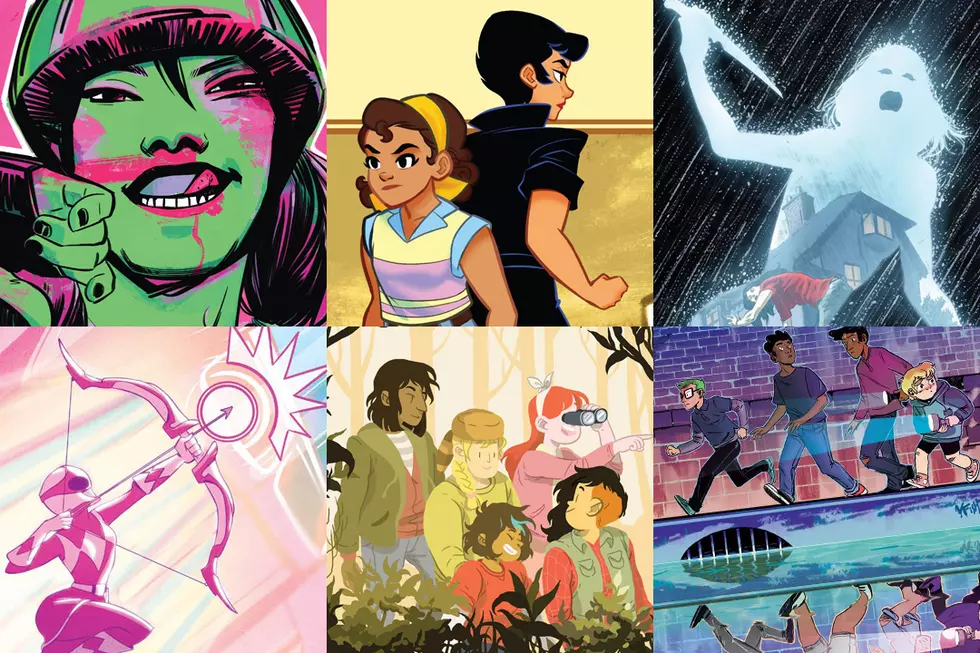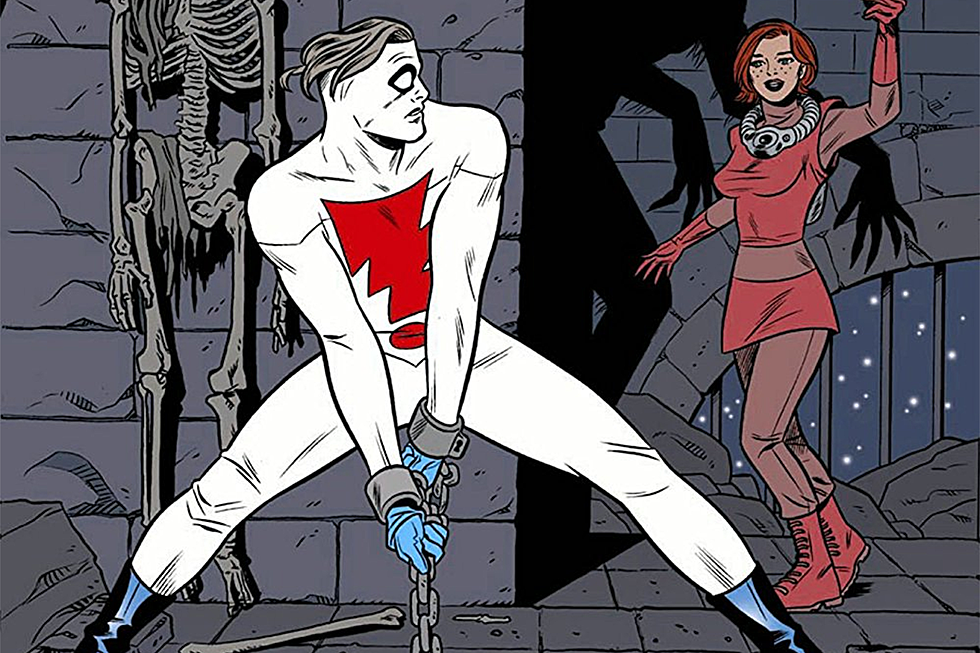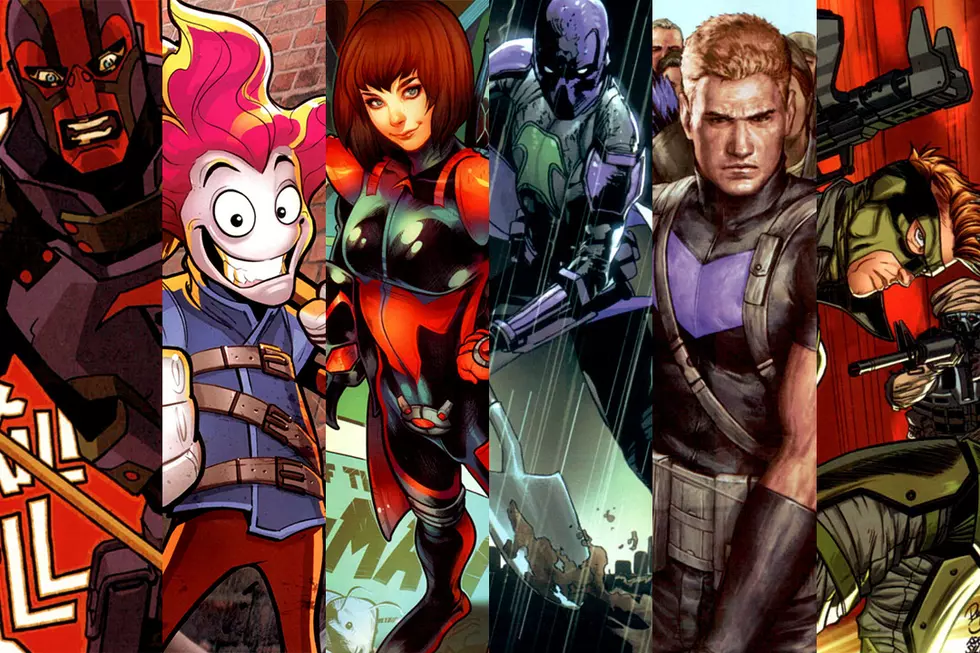![Colinet And Charretier Announce ‘The Infinite Loop Volume 2: Nothing But The Truth’ [Exclusive Interview]](http://townsquare.media/site/622/files/2017/03/Loop02.jpg?w=630&h=956&zc=1&s=0&a=t&q=89&w=980&q=75)
Colinet And Charretier Announce ‘The Infinite Loop Volume 2: Nothing But The Truth’ [Exclusive Interview]
Originally released in 2015, Pierrick Colinet and Elsa Charretier's The Infinite Loop is one of those amazing stories that uses a wild sci-fi premise to cut straight to the humanity of its characters. It centers on Teddy, a time traveler responsible for erasing anomalies that result form other time travelers meddling with history, and she's very good at her job. When she discovers a "human-shaped anomaly" in the form of a beautiful woman, though, she begins to question whether a timestream without a person she's falling in love with is one that's worth saving.
Now, after its original time-bending climax, the story is returning in The Infinite Loop Vol. 2: Nothing But The Truth, with artist Daniele DiNicuolo joining Charretier and Colinet to tell the next chapter of Teddy and Ano's story. To find out more, I spoke with them about the changing political landscape of the past two years and the difficulties of thinking of stories as, well, infinite loops.
ComicsAlliance: Let's start with the basics: What are we looking forward to in Infinite Loop, Vol. 2? The universe has been reset, but where does that leave Teddy and Ano when we pick up?
Pierrick Colinet: The Infinite Loop, Vol. 2 picks up a few years after Teddy resets the universe. We quickly understand that it didn’t solve everything, and Teddy and Ano are still activists. They have acquired lots of experience since their first adventure and are much more inclined to get down and dirty when the situation requires it.
Elsa Charretier: Teddy and Ano are at the top of their game in this new volume. They’re fierce, and super effective. I like Pierrick’s idea to do a self-contained mini-series. The readers of the first book will get back Teddy and Ano, and new readers will be able to jump on volume 2 and still understand everything. The story is a perfect starting point, and I’m super excited to join Pierrick in the writing.
PC: This is precisely why we decided to work with a new artist. It’s a new chapter in Teddy and Ano’s life and we felt it’d be a good idea to translate that visually. We’re super happy to be teaming up with Daniele DiNicuolo; he is the perfect fit. He's bringing his touch, his wonderful clean lines and energy, yet still perfectly fits the tone of the original story. We can’t wait to show you more.
CA: As the title implies, Infinite Loop is a book about cycles and trying to break them. It's about recursiveness, which means that in a way, it's about sequels. When you sat down to do the sequel, is that something that you kept in mind thematically?
PC: Absolutely. Like you said, The Infinite Loop is about cycles and how history keeps repeating itself. The first volume focused on how people will always find new communities to bully, ostracize (and by extension, the fight for LGBTQ rights). Volume 2 is about what we’re living right now, how it seems awfully similar to past times we’d like to forget ever happened. When we started thinking about this new book, Trump and his communication techniques became a huge part of the conversation. All value judgments set aside and objectively, we studied how people reacted to him. What struck us the most is the lack of moderation on both sides - his impact on his supporters and opponents are so extreme and viewed through such opposite prisms that it feels like they live in two different dimensions. Each one accusing the other one of lying. That’s what we’ll be focusing on this new volume of The Infinite Loop.
Teddy finds herself during a mission in a small town where people are addicted to VR helmets that allows them to fantasize a life they don’t have. Basically, a town where people are addicted to lies. Which allows us to delve into Truth. Does Truth still matter? Is it okay to lie to create hope?
CA: There are a lot of obvious political influences and statements in Infinite Loop's first volume, and I thought those were interesting for a few reasons. There's a point where the story just sort of abandons subtlety, when you have Teddy zooming past quotes from Malcolm X and Harvey Milk. Did you worry that making the metaphor so literal would detract from the story, or was Teddy just past the point of subtlety at that point?
PC: It’s actually a question we asked ourselves during the early development of the story. Should The Infinite Loop be set in our reality, or should we create our own universe and tell our story through allegories? I felt it would be more powerful to actually show by actual facts, and actual historical figures that humankind has been making the same mistakes over and over again though History. Besides, the activist we’re mentioning are huge pillars of the fight for civil rights, and LGBTQ rights. It felt natural to include them in the story, and confront Teddy.
EC: It’s also coherent with Teddy’s evolution, as a person. If the first part of the book is about her discovering her sexuality and self-acceptance, the second part focuses on the importance of activism, the need to fight, relentlessly, for a better society.
CA: Along those same lines, the first volume came out in 2015. Obviously, we're living in a different climate, and while the messages in the first volume still resonate and feel important --- prescient, even --- did that make the decision to follow up now easier?
PC: We had been toying with the idea of doing a second volume for a while, but we didn’t have the right story. Then, the campaign happened, Donald J. Trump happened, and so many rights we thought were “acquired” are suddenly put in jeopardy. And of course to some extent, it fueled our need to tell another story with Teddy and Ano. I like a debate of ideas, and philosophy. If I have to do something different from the first volume, I’d say that we’ll try and confront both sides bit more, and maybe more open ideas that are opposite to my own. Not value judgement, but a confrontation of arguments.
CA: Visually speaking, I loved how the old trick of representing motion by drawing multiple versions of a figure in the same panel. Here, though, it takes on a new aspect. We see multiple versions of Teddy in the same panel early on, then we get multiple versions of her as conflicting voices in her head, and then by the end of it, that's something else that's been made fully literal and real. How did you arrive at setting that visual so early?
EC: That’s one of the perks of working in the same studio. Most of the time, when I work on a book, I get a finished script and a deadline. My job is then to find the best way to translate the writer’s vision. Working with Pierrick is a completely different process. We start working together at a very early stage, during the issues breakdown. He’ll tell me his sensations, what he’s trying to translate, and I’ll try and come up with visual ideas. Most of them eventually get tossed because they won’t necessarily fit the final script, but it gives him something to use at the writing stage.
For the new volume, our collaboration will be different. I will be co-writing with Pierrick, and Daniele DiNicuolo will handle the interior art. It’s an adjustment, because in a way, I have to let go of my two favorite ladies (at least the drawing part), but on the other end, it might make the scripting stage even more interesting, having to figure out everything before delivering the final scripts to Daniele. It makes the whole experience really exciting.
CA: Were there any other tricky visuals that fell into place in a way that clicked like that?
EC: I think that most of the storytelling tricks clicked rather naturally. Not necessarily easily though. Luckily, our respective visions for this book were really close from the beginning. That’s why the perspective of working with another artist was both exciting and a little scary. But Daniele got the feeling of the book right away. When he showed us his new design for Teddy, we knew we picked the right guy.
More From ComicsAlliance
![Greet The Day With A Song In ‘Ladycastle’ #1 from Delilah Dawson and Ashley A. Woods [Preview]](http://townsquare.media/site/622/files/2017/01/Ladycastle_001_Featured.jpg?w=980&q=75)

![Don’t Stop Her Now: The Infectious Enthusiasm Of Whitley & Charretier’s ‘The Unstoppable Wasp’ #1 [Review]](http://townsquare.media/site/622/files/2016/12/Unstoppable_Wasp_Featured.jpg?w=980&q=75)

![Shrinking, Flying, Dancing And Science In ‘The Unstoppable Wasp’ #1 [Preview]](http://townsquare.media/site/622/files/2016/12/Unstoppable_Wasp_Featured.jpg?w=980&q=75)




